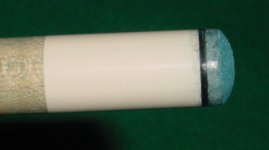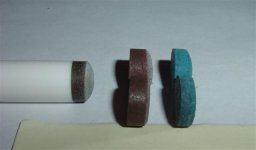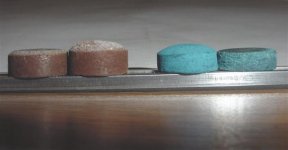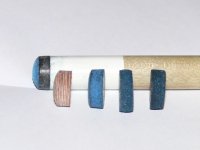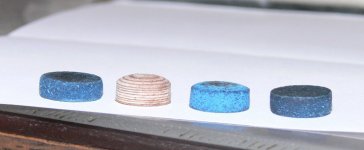To eliminate any moisture left in the tip. Bake at 100 degrees F in the oven (water boils at 100C or 212F). You can use a vise instead of the jig. If the jig is for the baking process instead of the pressing process, I would imagine it keeps the tip from expanding while drying out? (Not sure that even makes any sense. Shoulda quit while I knew what I was talking about...)Vahmurka said:And what is baking intended for? How is it usually done? (100 deg recalls me of boiling water) Can one perform it without such a jig?
You are using an out of date browser. It may not display this or other websites correctly.
You should upgrade or use an alternative browser.
You should upgrade or use an alternative browser.
Modifying Tips
- Thread starter Purdman
- Start date
Vahmurka said:I'm patientBut I could really put my present Triangle tip back if my duds don't meet my expectations or install a new one

BTW does it make sense trying to soak Triangles, or it is only Elk Masters the magic works with?
You are teasing meI'm about to lose patience lol. May be will try 'my' tip this week.
New 14mm Elks are .250 tall, + or - .005. I think it's best to know exactly how much they are compressed. In my case I soaked them for 30 minutes in warm water. The tip is saturated, so soaking them longer isn't necessary. I marked my vice with them compressed. It turns out they came out .185 tall.
At .185 tall they can easily be trimmed to a dime radius. In my case about a nickel radius with a 1/8" shoulder. It's the perfect height for feel/hardness and leave a fair amount of tip.
Triangles can be compressed as well. I just installed two on another cue but have yet to play with them. 14 mm Triangles are a taller tip compressed so you have a taller tip installed.
Here is 3 photo's. First is a water dud on my Schon.
2nd is a compressed Triangle on my Gilbert and a view of compression of both Elk and Triangle compared to new.
3rd is another view of the two compressed tips compared to new. Note they are not flattened so much they are hard. The elk plays like a medium but feels a bit softer. It is at least 3 months old. As I said you have to have some idea of compression in case you want more or less.
Rod
Attachments
Vahmurka said:I'm patientBut I could really put my present Triangle tip back if my duds don't meet my expectations or install a new one

BTW does it make sense trying to soak Triangles, or it is only Elk Masters the magic works with?
You are teasing meI'm about to lose patience lol. May be will try 'my' tip this week.
I haven't tried the milk treatment with other tips. All I have to say is the milk duds are the nuts...
Quite hard for a man used to metric system (i.e. me) to figure out .185 or 1/8 lol. Still you guys call it 14 mm and not 3/4 whateverRod said:New 14mm Elks are .250 tall, + or - .005. I think it's best to know exactly how much they are compressed. In my case I soaked them for 30 minutes in warm water. The tip is saturated, so soaking them longer isn't necessary. I marked my vice with them compressed. It turns out they came out .185 tall.
I soaked mine in warm (at the beginning) milk, went for 24 hours as I noticed the tip got more saturated with time. I suppose even two hours wouldn't be enough, but 8 to 10 might be okay probably.
I picked milk because of caseine or whatever proteine in there, and not really pure milk but half-and-half because of more fat.
Here go my comparison pics inspired by yours. One installed @ my MacDermott is brand new ordinary Triangle, left to right: some laminated tip (Everest? I forgot), dry-pressed Elk Master, my two babies
Second pic: duds are left and right ones.
Notice milk duds are of same height as normal Triangle - with exception of a dome. Meaning the overall height after shaping will be less by these 3-5 mm.


I need to try it on anyway, may be it will show that I need to press them lighter. Changed my mind and will have to wait for another week when a local tournament finishes. I will need to practice with these first before any serious competition.
Yeah, one dud I pressed as hard as I could, another one slightly less. Now have to guess which one lol...you have to have some idea of compression in case you want more or less.
A mm is 0.3943 or call it .040 thousands. 1/8" is .125 so 3mm is .120 or 5 is .200. One dud, right center, looks more compressed. It looks about the same as mine before shaping. At that height it's not as tall as a triangle. That being, the triangle compressed enough to flatten the dome.
I think triangles are a bit more firm than a stock elk. For that reason I didn't compresss them as much as the elk. I still haven't a clue how the triangles play by a feel comparison. Possibly I'll try one out this week.
Rod
I think triangles are a bit more firm than a stock elk. For that reason I didn't compresss them as much as the elk. I still haven't a clue how the triangles play by a feel comparison. Possibly I'll try one out this week.
Rod
It would seem that if you didn't use a jig, the leather/hide would expand sideways instead of compressing as well or consistent. In the jig it would only compress the height a little and still be as hard or harder than without the jig. With consistent starting tips and consistent technique, you could easily duplicate the results. Just my thoughts as some time ago I had considered making a jig for compressing tips.
I was asked an interesting question I want to share here because the experience in this field is not well known. How do you press tips in the US, those who do? Last week I prepared some milk duds using a Japanese tip jig I borrowed from my friend. And he asked me which way I think is better to press tips - making them flat (pressing with flat surface rod), letting them remain dome shaped (pressing with "inside" sphere) or even making them being pressed inside like a bowl (pressing with "outside" sphere). The latter to make tip's center harder than the edges.
I don't even know if any of you have been thinking about that but I look forward your replies to learn that. (as a reference I prefer them keep their traditional dome form when being pressed)
I don't even know if any of you have been thinking about that but I look forward your replies to learn that. (as a reference I prefer them keep their traditional dome form when being pressed)
Layered Tip Tampering not recommended
Pressing and soaking and such can quite possibly make low grade leather (Elk Masters, Le Pro & Triangle) perform better; however laminated tips are a whole nother story.
Any thing that you do beyond what was done in manufacturing puts the tip at high risk for layer seperation. At Tiger the leather we use in all out tips is of the highest quality and hides are specifically chosen for there desireable properties with regard to pool playing.
On top of all that, layerd tips are expensive and experimenting costs $$$. LOL!
When laminated Tiger Brand tips are under a minimum of 30 tons of pressure, we can go to 50 , at glue up. I do not think that any bench vice or jig setup can come close to that.
, at glue up. I do not think that any bench vice or jig setup can come close to that.
Pressing and soaking and such can quite possibly make low grade leather (Elk Masters, Le Pro & Triangle) perform better; however laminated tips are a whole nother story.
Any thing that you do beyond what was done in manufacturing puts the tip at high risk for layer seperation. At Tiger the leather we use in all out tips is of the highest quality and hides are specifically chosen for there desireable properties with regard to pool playing.
On top of all that, layerd tips are expensive and experimenting costs $$$. LOL!
When laminated Tiger Brand tips are under a minimum of 30 tons of pressure, we can go to 50
Do you have a picture of your 12 tip jig that you would not mind showing?Pinocchio said:Very interesting! I had a machinest make me a jig where I can press 12 at a time. I'm currently experimenting with La Pro an Elkmaster. I've not heard of baking but 100 degrees makes sense. Sounds like a form of quick cure. I'm gonna give it a try. Rep for you!!!!!!!!!!!!1
Pinocchio
CrownCityCorey said:Pressing and soaking and such can quite possibly make low grade leather (Elk Masters, Le Pro & Triangle) perform better; however laminated tips are a whole nother story.
Any thing that you do beyond what was done in manufacturing puts the tip at high risk for layer seperation. At Tiger the leather we use in all out tips is of the highest quality and hides are specifically chosen for there desireable properties with regard to pool playing.
On top of all that, layerd tips are expensive and experimenting costs $$$. LOL!
When laminated Tiger Brand tips are under a minimum of 30 tons of pressure, we can go to 50, at glue up. I do not think that any bench vice or jig setup can come close to that.
Right...and SVB can beat us all with a house cue.
Boys and their toys!! (-:
CrownCityCorey said:When laminated Tiger Brand tips are under a minimum of 30 tons of pressure, we can go to 50, at glue up. I do not think that any bench vice or jig setup can come close to that.
Hmmm, an interesting comment so I checked. A Kurt D100 torqued to 160 ft-lbs (I can do that, honest
Dave
DaveK said:Hmmm, an interesting comment so I checked. A Kurt D100 torqued to 160 ft-lbs (I can do that, honest) will apply about 12,000 lbs of force, which would equate to about 120,000 psi on a 13mm tip. Don't underestimate the power of a good screw

Dave
Interesting......
That is certainly beyond my technical scope.
Still really a bad idea after the glue has already dried.
Last edited:
I made this simple jig with phenolic tube. I made concave/flat disks that go in the jig between soaked tips. I use two short pieces of rod to apply the pressure to stack in a vise. The pictures show the parts and a pressed tip. It does eight at a time. After claming for several hours I move the stack in the jig to a big C-clamp and bake it at 125.




DaveK said:Hmmm, an interesting comment so I checked. A Kurt D100 torqued to 160 ft-lbs (I can do that, honest) will apply about 12,000 lbs of force, which would equate to about 120,000 psi on a 13mm tip. Don't underestimate the power of a good screw

Dave
NEVER!!
(-:
